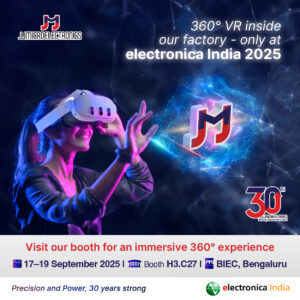Smart Displays: Brightness Sensors in Automotive Infotainment Systems
The new infotainment systems in modern vehicles have increasingly developed into the central operating and control elements of the car. With the growing number of offered functions — such as music streaming, navigation, interior, and temperature control — there is a clear trend toward ever-larger and higher resolution displays inside the vehicle. As displays are now also being used for driver information and assistance systems, solutions that ensure good readability are becoming more important for driving safety and comfort.
Vishay Opto Offers a Wide Range of Digital Sensors for Brightness Adjustment and Color Correction in Automotive Display Applications
To ensure display readability under different lighting conditions and ambient brightness levels, brightness sensors are integrated into displays to adjust backlighting in real time. For this purpose, Vishay offers AEC-Q100 qualified digital ambient light sensors (ALS) specifically designed for brightness measurement in automotive environments.
Adjusting display brightness is crucial for optimal contrast and good readability of displayed content. In infotainment systems, ALS measure the surrounding brightness inside the vehicle. Based on this value, the display backlight is automatically controlled according to the ambient light level to ensure optimal readability and enhance comfort. Because ambient lighting can vary greatly, ALS must be able to handle a wide dynamic range — from intense sunlight on a summer day to minimal illumination during night driving — so the display brightness is always optimally adapted to the driver’s environment.
To determine the required cabin brightness, Vishay ALS use special filters that limit incoming light to the visible spectrum (380 nm to 750 nm). These filters reproduce the human eye’s light sensitivity curve, V(λ), which is used to calculate ambient brightness. The sensors output a 16-bit digital value that can be converted to illuminance in lux.

Figure 1: Typical spectral behavior of Vishay ALS/RGB sensors compared to the human eye
Since many light sources also contain wavelengths from the non-visible infrared spectrum, ambient light sensors include an additional infrared channel. This channel is typically used in combination with the ALS channel to improve brightness measurement accuracy across different light sources.
Another advantage of Vishay’s digital ALS is their flexible measurement parameter configuration. For example, the VEML4031X00 can detect brightness from as low as 0.003 lux up to 172,000 lux. Measurement times as short as 3 ms can be set, allowing multiple rapid measurements and therefore fast display response. Thanks to this wide dynamic range, the sensors can be used both under transparent and dark-tinted display covers that reduce incoming light by up to 98%.
Because of their wide and flexible measurement range, these sensors are found in various display devices — for example, infotainment screens, digital dashboards, and smart mirrors.
RGB Sensors: The Next Generation of Brightness Sensors
To adjust not only the brightness but also the color characteristics of display backlighting according to the surrounding light, Vishay offers automotive-qualified RGB sensors such as the VEML6046X00 in addition to its ALS devices. Using filter technology, the visible spectrum is divided into red, green, and blue channels. This separation forms the basis for display color correction and is used in applications where sensors are exposed to constantly changing lighting conditions. With these three color channels, both brightness and color tone can be dynamically adjusted to match the ambient environment.
This capability is particularly important in the emerging market for heads-up displays (HUDs), which use RGB values to achieve maximum display contrast. Adjusting display color ensures that driving information always remains visible and legible. RGB sensors are also used in digital instrument clusters and infotainment systems, where they ensure consistent and accurate color representation.

Figure 2: Color perception at different color temperatures
Figure 2 illustrates the effects of ambient light color composition on a display’s appearance under three lighting conditions. In all three cases, the driver perceives the incoming light as “white,” but its spectral composition differs, leading to changes in perceived display color.
From left to right, images 1 and 2 show displays without color temperature correction. The first shows the influence of warm-white illumination, such as during evening twilight (3000 K), where red components dominate the sunlight spectrum. The second shows cold-white illumination, for instance under LED lighting in a tunnel, where blue components dominate. In both cases, the perceived display colors are distorted by the lighting conditions.
The right-hand example at 6000 K shows a color-controlled backlight that adapts display tones to the correlated color temperature (CCT) of the ambient lighting. This ensures consistent and accurate color perception regardless of lighting spectrum — maintaining optimal display readability and driver comfort.
To ensure optimal performance under all environmental conditions, Vishay ALS and RGB sensors feature integrated temperature compensation, ensuring measurement accuracy across temperature variations. In addition, the FAM package design reduces interference from stray light sources typically found inside display electronics.
Vishay’s New ALS and RGB Sensors Support the Trend Toward Brightness and Color Temperature Control in Automotive Infotainment Systems
As display and visualization systems become increasingly integrated into modern vehicles, demands on infotainment and driver assistance readability continue to rise. Consequently, sensors for brightness detection and color correction are gaining importance in the automotive industry.
Vishay’s digital ALS and RGB sensors provide adaptive brightness control solutions that enhance both driving safety and user comfort. The new RGB sensors, such as the VEML6046X00, enable precise color matching and support the next generation of user interface and display designs.
With the growing popularity of ever-larger displays, demand is also rising for space-saving sensors. To meet this need, Vishay’s portfolio includes the VEML6031X01, VEML6046X00, and the newly introduced VEML4031X00. The latter’s compact dimensions (3.48 mm by 1.45 mm by 0.6 mm) make it ideal for integration into displays with narrow bezels.
Beyond the light and color sensors described here, Vishay Opto offers a broad range of additional sensor solutions for automotive applications, which can be explored on the company’s website:https://www.vishay.com/en/landingpage/opto-automotive-solutions/.










